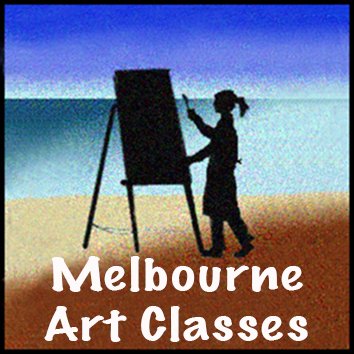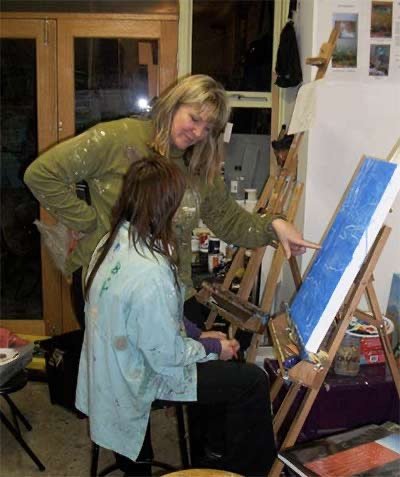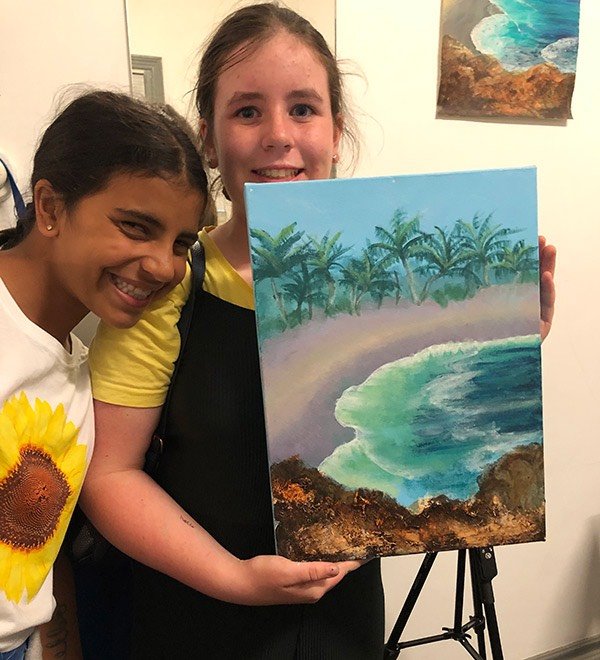Room Set-up for Drawing and Painting
SETTING UP A GREAT PLACE TO DRAW AND PAINT EFFECTIVELY AND COMFORTABLY
Hardly anyone has a huge light-filled studio at their disposal when they are learning about art, colour and design. Natural light is ideal but weather and other constraints mean that clever use of electrical lighting is necessary for many artists and certainly most students. If you could work comfortably in a sheltered area outside, you would be in my idea of lighting heaven. Even a north-facing window will still give changing light conditions all day. Many students and artists only get to work at night in any case.
ELECTRICAL LIGHTING
Michaelangelo used a candle strapped to his head whilst up on a scaffold laying on his back working on the Sistine Chapel. Fortunately, we have a range of options available to us to help arrange suitable lighting indoors, without such discomfort and struggle. Too much light can cause issues as well. Your enjoyment and progress with drawing and painting are very much contributed to by your physical comfort as are your results in terms of value patterns and colour mastery.
TEMPERATURE AND KELVIN MEASURE - Having a daylight setting (or cooler type) temperature of light is best in your work area. Michaelangelo’s candle was about 1800 K, we are looking for about 5000 K
INTENSITY AND LUMENS MEASURE - measuring light values (equally important element in your drawing and paintings) can be harder if your ambient light is too weak or too strong). The distance between the light source and your easel or table surface can be adjusted you can get a white (of your canvas or paper) closer .to what it would be in daylight. (don't do like this guy and have the best light shining onto your face and the back of your canvas!)
WATTAGE - will vary depending on the size of the room, and distance of your easel or table from the light, in general (Watts measure the power required to meet the functions of the appliance)
ANGLES FOR YOUR LIGHTING
At 45 DEGREES from the side/behind is the ideal angle to avoid glare or shadows (not like this guy who positioned himself with the light in his face instead of on his work.
DISTANCE
Ideally, a portable tall lamp stand can be moved as required, or you can move your easel to be in a better location/distance/angle to your light source(s) if what is there that is all you can have. (at least you do not have to strap a candle to your head). Don’t laugh. when we work late in the outdoor studio, we sometimes strap a dog walking LED to the head to add grunt to a portable LED panel hanging from my cantilever umbrella). It is not a cool light but can be used just to boost visibility temporarily.
One on either side from behind the easel is ideal, but suspended above a desk if you paint flat is a great option if you find yourself able to do that (having said that, tilting your canvas or pad a little with a book or similar ( if you are at a desk or on the dining room table), at least 30 degrees is better for equally visualizing the proportions properly)
TYPES OF LIGHT FITTINGS
LED PANELS - Since I moved into my new studio (where the electrician who “knew how to
light a studio” installed wall-mounted spotlights (!!!) I have installed portable LED panels on the ceiling, but you can also get these from hardware and electrical suppliers with a stand and they come with options of warm, cool and daylight (that way if you are setting up in a bedroom, lounge room or similar, they can easily be tucked way after use.
CFL bulbs
If you only have the option of using current fittings and putting a better bulb for the job, look for Compact Fluorescent Light Bulbs eg. 45W , 5500 K CFL Daylight bulbs (Emart). Then move your desk or easel around to avoid glare, shadows or uneven spread of light.
EASEL OR DESK?
Many people have a picture of a ‘real' artist toiling away at an easel, so one of the first things they out on their shopping list is an easel. Before discussing easels, let me just point out that millions of excellent paintings and drawings have been created on a table, desk, on the floor or even hanging on the wall, so if you don’t try all methods you may end up with an easel when you prefer to work another way.
Easel vs Desk
Many people have a picture of a ‘real’ artist vigorously toiling away at an easel, so one of the first things they put on their shopping list is an easel. Before discussing easels, let me just point out that millions of excellent paintings and drawings have been created on a table, desk, on the floor or even hanging on the wall, so if you don’t try all methods you may end up with an easel when you prefer to work another way.
There are nice drafting tables that will tilt or be flat and have lots of places to store your drawing media. They are suitable if you have a permanent area to use that is not required for anything else.
You may have a little study desk. If you have a big book (or another object suitable, you can create a tilt of 30-60 degrees for leaning on a canvas, canvas board or drawing pad (best against a board). Working flat on the desk works well for some who have no other option (and a good overhead or natural light source). Not ideal if any kind of accurate perspective is required in your project.
FLOOR PROTECTION
If your ‘studio' is also your shared lounge or other household room, use waterproof floor coverings (like house painters use) if you want to avoid paint or painty water from causing a new permanent (unwanted) look. If you get to use the garage, you could worry less (and there would possibly be more framework options for hanging LED light panels above.
Regular Art Group Classes for Adults
Adult Drawing Classes Melbourne
Zoom Art Classes - Options
Private Art Tuition - Melbourne Art Classes
Art Class Gift Certificates Melbourne
About Art Materials for Melbourne Art Classes
Team Building Art Workshops
Casual Art Workshops
Kids Art Classes
DIY workbooks and online courses
Framing for Art Students and artists
Family Friendly Art Workshops


















